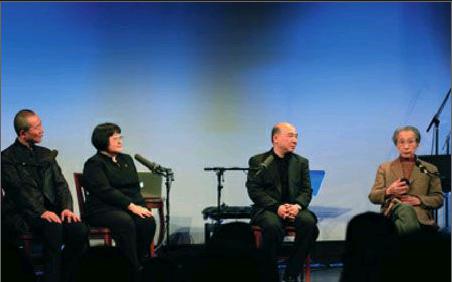Cultures in Concert
2015-02-10ByCorrieDosh
By+Corrie+Dosh

What value can be ascribed to a once-ina-lifetime opportunity? The opportunity of a teacher who fosters a talented student that touches the entire world with his gift of music. This is the story of Chinese American composer Chou Wen-Chung and the opportunity he gave to three young Chinese composers—Tan Dun, Zhou Long and Chen Yi—who have gone on to win some of the highest and most coveted artistic awards in their field.
“Life is a dream,” said Tan Dun, winner of a Grammy Award, an Academy Award, Grawemeyer Award and many other accolades for classical music, taking the stage on January 10 at the New-York Historical Society for a program titled From China to America. “Its so beautiful.”
A musical journey
Tan, Zhou and Chen first became acquainted with Columbia University Professor and composer Chou as students at the Central Conservatory of Music in Beijing in the 1970s.
At the end of the 1970s Chinese American professors frequently came to Beijing to see the rise of the first generation after the “cultural revolution (1966-76).” Professor Chou encouraged us to see the whole world. At that time, we had no idea what was happening beyond Beijing, what the world was like. So we gave him
scores and recordings on cassette tapes. He told us to learn from the best and equip yourself spiritually with what other people know and you will recognize yourself more deeply and truly,”said Tan.
Rooted in the tradition of cultural exchange through the Silk Road, Chou taught his students to open their minds to Western masters as they developed their own unique compositions. The three fledgling composers were selected by Chou to continue their studies at Columbia University in New York.
Chou shared with Beijing Review the reasons why he selected each composer. First selected was Zhou, “highly recommended by every leader that you could think of in Beijing,”Chou said. Though Zhou was diligent, he was“unhappy” in New York.
“I asked him what was the matter and he said he was married—I didnt know he was married—and that he couldnt possibly live and compose when his wife Chen was not with him.” Chou said. “As the professor in charge of admissions, this was a little difficult for me to respond to, but in order to keep him in good health, I had to offer an invitation to his wife—who, I soon discovered, was the other half of this composing duo, and it turns out that she was equally highly recommended. Im glad we are all composers together now.”
When Chen arrived, Chou was surprised to learn she had never composed for traditional Chinese instruments and promptly required her to compose a piece for the pipa. Her devotion and tenacity impressed Chou.
“Tan Dun was even more dramatic. He would do things that no one else would ever dream of. I was hit with it the moment I met him. I attended a concert in Beijing and I felt a tug on my shirt as I was sitting down. I turned around and it was someone making a gesture for me to come out. It was Tan Dun and he told me that he could not submit his scores to me because his faculty professors felt he was ‘not following the correct direction,” Chou said. “I helped him come to Columbia University.”
The three Chinese students soon settled into a routine of lectures, composing and regular meetings with Professor Chou to discuss life, philosophy, food and art. Most of these discussions took place over wonderful meals that became a metaphor for the art of producing original music.
“Like a cook really looks at the ingredients and recipes, I remember thinking that if I really wanted to know Professor Chous secrets for composing songs, I have to deconstruct them. I have to find out what is the garlic, what are the spices,” said Tan.
Composing is also like the art of calligraphy, Chou said, and both are a form of personal expression. Each note is like a brush stroke, connecting melodies into a complete song. Before beginning, the calligrapher makes sure his paper is weighted and his ink and brushes are placed properly, and spends a long time adjusting the ink on his brush, all the while thinking of each stroke he will make on the paper.
“When [the calligrapher] is doing that, he is really composing, and once he starts, there is no stopping. The rule is you never correct it. To me thats a fundamental difference in creative thinking between East and West,” Chou said.
There is no question that the East and the West are coming closer together in artistic expression. We are at “the beginning of a new era,” Chou said.
“It is my opinion that we will be much happier in the future if we understand the relationship between East and West,” he said. “The next stage is for the two to come together and thats the reason why these composers are here.”
To honor Professor Chou, the Talujon Percussion Quartet performed his haunting composition Echoes From the Gorge. The piece represents a summation of all of the concepts, both Eastern and Western, acquired and utilized by the composer throughout his career with Western percussion practices and an intrinsic structure comparable to Chinese ideograms, according to the program notes.
Using Western classical instruments, the Ying Quartet then performed Song of the Chin, from Zhou, and Chens composition Shou. Concluding the performance was Maya Beiser—nicknamed the “cello goddess”—performing Tans Feige (Flying Song).
Exclusion/inclusion
The event was presented by the U.S.-China Cultural Institute and the Cultural Associate of the Committee of 100 at the New-York Historical Society Museum and Library. The program highlighted the contributions of Chinese American artists as part of a six-month, $2.8-million exhibit titled Chinese Americans: Exclusion/ Inclusion, which explores the centuries-long history of trade and immigration between China and the United States.
The saga of Chinese Americans includes the building of the Transcontinental Railroad; the unprecedented immigration legislation known as the Exclusion Act of 1882, which barred most Chinese from entering the United States; and the Chinese American activists who used the American justice system to try to overturn the Exclusion Act. Future programs highlighting the contributions of ethnic Chinese artists include events featuring choreographer Shen Wei, opera singer Hao Jiang Tian and author Amy Tan.
Music is a symbol of the transition from exclusion to inclusion, said Louise Mirrer, President and CEO of the New-York Historical Society. Chinese music and American music have become closer, and now often blend together creating a new art form. Tan, with his modern interpretations rooted in classical Chinese music, is a perfect fit for the series.
“We are extremely pleased to have with us Tan Dun, a Chinese artist of such exceptional talent and renown. We are very excited to have attracted so many Chinese and Chinese American visitors to our institution interested in learning this important story,” Mirrer said.
President of the U.S.-China Cultural Institute Shirley Young (Xue Lan Yang) said the exhibit highlights the stories of Chinese Americans lives, achievements, culture and rich diversity.
“Chinese in America have experienced many hardships and challenges from the early days,” Young said, “including the early Chinese laborers helping railway construction and laborers hoping to strike it rich in Californias gold rush. This is a sad history and this history shaped American society. Starting in the 19th century, Chinese Americans resisted and protested discriminatory legislation, including the Exclusion Act.”
Despite the hardships, Sino-U.S. relations have prospered, and the spirit of inclusion has triumphed, producing extraordinary individuals such as talented musicians Chou and Tan as well as many other specialists in different fields, Young said.
“Many Chinese people come to America for further education or business. And many Chinese elites such as Tan Dun bring their contributions to the United States,” Young said. “These musicians success shows part of Americans inclusion, also a part of Americas history.”
